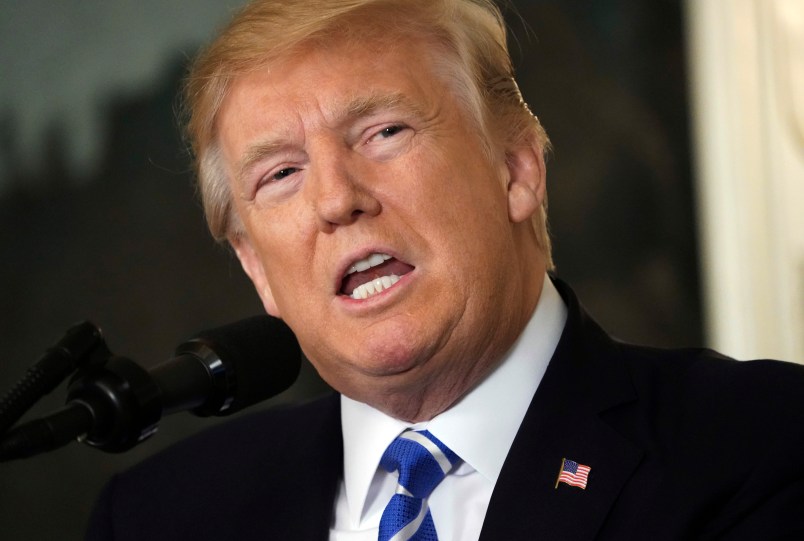WASHINGTON (AP) — Overhauling welfare was one of the defining goals of Bill Clinton’s presidency, starting with a campaign promise to “end welfare as we know it,” continuing with a bitter policy fight and producing change that remains hotly debated 20 years later.
Now, President Donald Trump wants to put his stamp on the welfare system, apparently in favor of a more restrictive policy. He says “people are taking advantage of the system.”
Trump, who has been signaling interest in the issue for some time, said this past week that he wants to tackle the issue after the tax overhaul he is seeking by the end of the year. He said changes were “desperately needed in our country” and that his administration would soon offer plans.
For now, the president has not offered details. Spokeswoman Sarah Huckabee Sanders said more specifics were likely early next year. But the groundwork has already begun at the White House and Trump has made his interest known to Republican lawmakers.
Paul Winfree, director of budget policy and deputy director of Trump’s Domestic Policy Council, told a recent gathering at the conservative Heritage Foundation that he and another staffer had been charged with “working on a major welfare reform proposal.” He said they have drafted an executive order on the topic that would outline administration principles and direct agencies to come up with recommendations.
“The president really wants to lead on this,” Winfree said. “He has delivered that message loud and clear to us. We’ve opened conversations with leadership in Congress to let them know that that is the direction we are heading.”
Trump said in October that welfare was “becoming a very, very big subject, and people are taking advantage of the system.”
Clinton ran in 1992 on a promise to change the system but struggled to get consensus on a bill, with Democrats divided and Republicans pushing aggressive changes. Four years later, he signed a law that replaced a federal entitlement with grants to the states, placed a time limit on how long families could get aid and required recipients to go to work eventually.
It has drawn criticism from some liberal quarters ever since. During her presidential campaign last year, Democrat Hillary Clinton faced activists who argued that the law fought for by her husband punished poor people.
Kathryn Edin, a professor at Johns Hopkins University who has been studying welfare since the 1990s, said the law’s legacy has been to limit the cash assistance available to the very poor and has never become a “springboard to work.” She questioned what kinds of changes could be made, arguing that welfare benefits are minimal in many states and there is little evidence of fraud in other anti-poverty programs.
Still, Edin said that welfare has “never been popular even from its inception. It doesn’t sit well with Americans in general.”
Robert Rector, a senior research fellow at Heritage, said he would like to see more work requirements for a range of anti-poverty programs and stronger marriage incentives, as well as strategies to improve results for social programs and to limit waste. He said while the administration could make some adjustments through executive order, legislation would be required for any major change.
“This is a good system,” he said. “We just need to make this system better.”
Administration officials have already suggested they are eyeing anti-poverty programs. Trump’s initial 2018 budget proposal, outlined in March, sought to sharply reduce spending for Medicaid, food stamps and student loan subsidies, among other programs.
Budget director Mick Mulvaney said this year, “If you are on food stamps and you are able-bodied, we need you to go to work.”







In Trump’s case, reform = destroy.
Gotta get rid of all those mythical “welfare queens.” They’re mostly black, you know. I heard it from my uncle’s second half-cousin twice removed who knew a guy who did a 4 hour shift in a grocery store once back in 1995 (who got fired for shoplifting, but not really, it’s just because the owner was a Jew) and he saw one of them welfare couples, dressed to the nines, roll up in a Cadillac and buy steak with food stamps. It’s true. I swear.
Good. He should start with the DOD. They know where the fat should be cut.
WELfare queEns driVing arouND in Cadillacs talkinG on their obamaphones eaTing lobsTer! ShoulD be eaTing poor peoplE food.
Stupid, stupid ignorant man-baby with a head full of nonsense elected by stupid, stupid, ignorant people to do stupid, stupid things sets sights on next stupid, nonsensical thing he wants to do.
So naturally AP strokes its chin and solemnly goes about talking to experts on Both Sides and reports it as a story about Very Serious People seriously talking about doing Very Serious Things.
Dolt 45’s idea of “Welfare Reform”–Get those lazy seniors off their butts and make 'em work at McDonalds, turning our those Super Sized Big Mac meals that he loves to munch on…